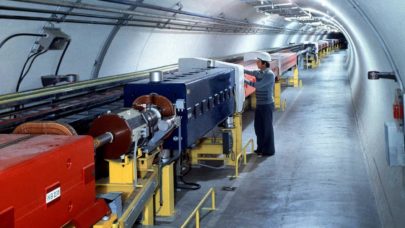
NCSA’s Delta System Enters Full Production
October 5, 2022
In June 2020, the NSF awarded the National Center for Supercomputing Applications (NCSA) $10 million for its post-Blue Waters “Delta” supercomputer. Now, th Read more…

Five Supercomputers Help Model Crucial Elements of HIV-1
February 25, 2022
The Covid-19 pandemic has brought into sharp relief how small elements of a virus can play a crucial role in combating it with therapeutic drugs and vaccines. I Read more…

USDA-Backed Agrivoltaics Project to Use New NCSA Supercomputer
October 28, 2021
“Agrivoltaic,” a portmanteau of agriculture and photovoltaic, describes crop fields that include photovoltaic solar panels. It’s an efficient proposition Read more…

NCSA Supercomputer Helps Identify Tsunami Risks
May 22, 2021
Researchers don’t always understand why certain tsunamis are so devastating: take, for instance, the 2018 tsunami that struck Sulawesi in Indonesia, killing m Read more…

NCSA Supercomputer Helps Monitor Extraterrestrial Pothole
February 8, 2021
You might not be driving in space anytime soon, but one extraterrestrial pothole could still cause you a headache back on Earth. The “pothole” in question is called the South Atlantic Anomaly (SAA): a weak spot in Earth’s magnetic field that extends over South Africa, South America and... Read more…

Supercomputers Simulate 800,000 Years of California Earthquakes
January 30, 2021
The relative rarity of data from major earthquakes is a double-edged sword: on one hand, it means that major earthquakes are relatively rare, which is good; on Read more…

NASA Uses Supercomputing to Measure Carbon in the World’s Trees
October 22, 2020
Trees constitute one of the world’s most important carbon sinks, pulling enormous amounts of carbon dioxide from the atmosphere and storing the carbon in thei Read more…

Frontera Assists CERN Proton Experiments
June 10, 2020
At the European Organization for Nuclear Research (CERN), over 200 physicists across dozens of institutions are collaborating on a project called COMPASS. This Read more…

- Click Here for More Headlines

Whitepaper
Transforming Industrial and Automotive Manufacturing
In this era, expansion in digital infrastructure capacity is inevitable. Parallel to this, climate change consciousness is also rising, making sustainability a mandatory part of the organization’s functioning. As computing workloads such as AI and HPC continue to surge, so does the energy consumption, posing environmental woes. IT departments within organizations have a crucial role in combating this challenge. They can significantly drive sustainable practices by influencing newer technologies and process adoption that aid in mitigating the effects of climate change.
While buying more sustainable IT solutions is an option, partnering with IT solutions providers, such and Lenovo and Intel, who are committed to sustainability and aiding customers in executing sustainability strategies is likely to be more impactful.
Learn how Lenovo and Intel, through their partnership, are strongly positioned to address this need with their innovations driving energy efficiency and environmental stewardship.
Download Now
Sponsored by Lenovo
Whitepaper
How Direct Liquid Cooling Improves Data Center Energy Efficiency
Data centers are experiencing increasing power consumption, space constraints and cooling demands due to the unprecedented computing power required by today’s chips and servers. HVAC cooling systems consume approximately 40% of a data center’s electricity. These systems traditionally use air conditioning, air handling and fans to cool the data center facility and IT equipment, ultimately resulting in high energy consumption and high carbon emissions. Data centers are moving to direct liquid cooled (DLC) systems to improve cooling efficiency thus lowering their PUE, operating expenses (OPEX) and carbon footprint.
This paper describes how CoolIT Systems (CoolIT) meets the need for improved energy efficiency in data centers and includes case studies that show how CoolIT’s DLC solutions improve energy efficiency, increase rack density, lower OPEX, and enable sustainability programs. CoolIT is the global market and innovation leader in scalable DLC solutions for the world’s most demanding computing environments. CoolIT’s end-to-end solutions meet the rising demand in cooling and the rising demand for energy efficiency.
Download Now
Sponsored by CoolIT
Advanced Scale Career Development & Workforce Enhancement Center
Featured Advanced Scale Jobs:
HPCwire Resource Library
HPCwire Product Showcase
© 2024 HPCwire. All Rights Reserved. A Tabor Communications Publication
HPCwire is a registered trademark of Tabor Communications, Inc. Use of this site is governed by our Terms of Use and Privacy Policy.
Reproduction in whole or in part in any form or medium without express written permission of Tabor Communications, Inc. is prohibited.
























